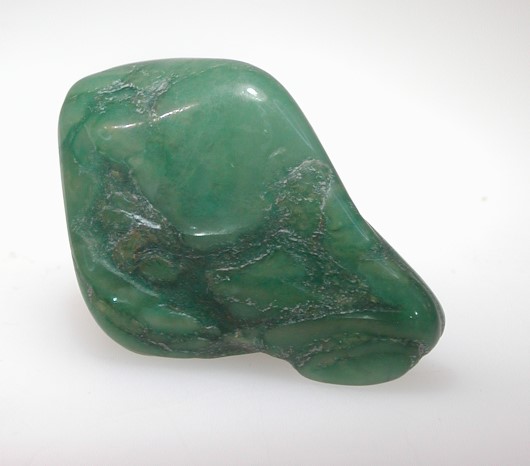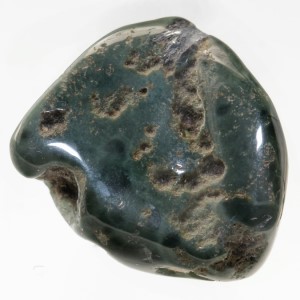
Genuine Prasem from Serifos, Greece, as our ancestors used to know it.
The term »Prasem« appeared for the first time in 1778 in a Latin to German translation by Johann Friedrich Gmelin. The word originates from the Latin term for "leek green", which, in turn, was derived from the Greek word for "leek" (práson). Thus, the term »Prasem« originally described a color.
In order to determine which color this "leek green" really stood for, we have to look at the material that was available as »Prasem« at that former time. One of the old deposits is located in Greece on the island of Serifos. The sites on the Italian island of Elba might have been known as well. The leek green Quartzes found there have inclusions of the green amphibole mineral Actinolite and / or Hedenbergite. These inclusions are responsible for the green color. At different sites, actinolitic Hornblende can be a coloring factor as well. However, this has not been verified yet. As Actinolite, Hedenbergite and Hornblende are all belonging to the same amphibole-group and are chemically very closely related, we can make the following summary: The color of all of these Quartzes is caused by green amphibole minerals. This is the benchmark for all kinds of »Prasem« in today's market.
Conclusion:
»Prasem« used to be a term for green colored Quartz. Today, we would call it "Green Quartz". Thus, the definition: "Prasem is a type of green Quartz" is fully acceptable.
However, the reverse conclusion is NOT acceptable: Not all green Quartzes can be called »Prasem«. Apart from the color, another essential part of the definition of »Prasem« Quartzes are the kind of coloring inclusions.
The complete definition is:
»Prasem« is a (leek) green Quartz. Its color is caused by inclusions of green amphibole minerals.
At the above-mentioned ancient sites in Greece (Sefios) and Italy (Elba) those conditions are given. Besides these, sites in France, Spain and the United States are known as well.
Other rocks that are erroneously traded as »Prasem«:
As time goes by the EPI laboratory has systematically analyzed rocks offered in the trade as »Prasem«.
»Budstone« (Greenstone)

Erroneously called prasem: »Budstone« (Greenstone), South Africa
Foto: K. Sieber, www.makrogalerie.de
In 2014 we examined material from South Africa. To our surprise, we found that the examined rocks did not even contain Quartz, let alone green amphibole minerals. Instead we found Feldspar and green Phyllosilicates / sheet silicates (Fuchsite, Clinochlore). The mineral paragenesis is consistent with a metamorphic rock called in geology "Green Shist" (trade name: »Budstone«). Read our article about »Budstone« (Greenstone).
Fuchsit-Quarzit
In 2017 we analyzed Green Quartz from Australia that was marketed as »Prasem«. In this case we actually found a considerable amount of Quartz and a small content of Fuchsite mica. We are already aware of such types of rocks from other parts of the world. India is the origin of a Quartz rock with green Fuchsite mica flakes that sparkle conspicuously. This light-effect is called "Aventurescence". Accordingly, this sparkling quartz is called »green Aventurine-Quartz«.
Fuchsite-Quartz without this glittering light effect come from Brazil, the Urals, South Africa and now from Australia also. Since they lack the aventurizing light effect they are called »Green Quartz« or »Fuchsite Quartz«.
References:
Des Ritters Carl von Linné vollständiges Natursystem des Mineralreichs, nach der zwölften Lateinischen Ausgabe. In einer freyen und vermehrten Übersetzung von J. F. Gmelin. 4 Teile, Gabriel Nicolaus Raspe, Nürnberg 1777–1779






